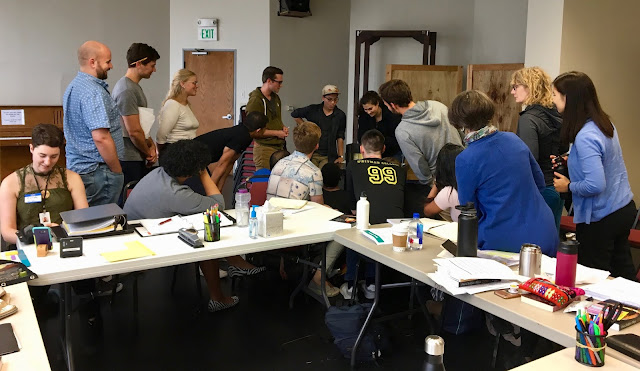History with the Play, History with Each Other: M.F.A. Students Present Three Sisters
By Annie Sears
 |
| The cast and crew of Three Sisters gather around the scenic model before beginning their first read-through. Photo by Annie Sears. |
Russian playwright Anton Chekhov (1860–1904) is one of the most well-known theater-makers of all time—from The Seagull (1896) to The Cherry Orchard (1904) to Three Sisters (1901), which our third-year M.F.A. students will perform next week. Rehearsals began three weeks ago, but their excitement was sparked long before that. Our M.F.A. students have a special history with this play, and their history with each other makes it the perfect selection.
Students first tasted Chekhov’s complexity their first year. In a course with former Head of Voice Jeff Crockett, they explored several Chekhov plays, but Three Sisters was their favorite. “There's something about this particular mixture of loneliness, desire, and humor—iconic traits in all of Chekhov's work—that resonated with my class,” says Caleb Lewis. “So over the last two years, we’ve subtly campaigned to put on the full show.”
“When the topic of shows came up in meetings or over email,” says Jerrie R. Johnson, “a classmate or two would always put Three Sisters out there, just as a suggestion. As first-years, we didn’t think we really had a say. But I guess the universe—and the faculty—heard us!”
Some might be surprised that this text is so appealing to young actors. Chekhov was one of the pioneers of realism onstage, which means he “is often pinned for being mundane and not having much happen,” says William Hoeschler. “But in reality, tons of things happen. Chekhov’s plays are like icebergs. They seem like simple stories, but underneath the surface is a wild, complicated, and rich world.”
In Three Sisters, that world is a small Russian town. Chekhov doesn’t offer a specific location, but point is: it’s not Moscow. Sisters Olga, Masha, and Irina want nothing more than to escape their provincial lives, jobs, and love lives. They’re convinced that moving to Moscow will be their salvation, but getting there isn’t easy. Through Three Sisters, Chekhov depicts “the loneliness, the rhythms, and the beating hearts of these humans he creates,” says Adam Donovan.
Because many of these characters are family, “they have deep, complicated, histories with each other,” says Hoeschler. “That’s why this play is perfect for us. It benefits from actors who know each other, and we’ve spent the last two years working and living in close quarters.”
Working on this script bookends these students’ three-year journeys nicely. They’ll see how they’ve grown not only as actors, but also as friends. “We’ve endured a lot together,” says Donovan. “I’m honored to share the stage with brave artists and brave humans.”
Three Sisters opens in less than a week, running September 27–29 at The Strand. Get your tickets today!

